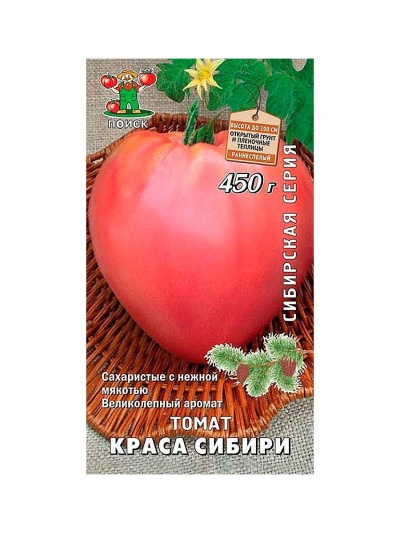
- Authors: Ognev V.V., Khovrin A.N., Maksimov S.V., Tereshonkova T.A. (OOO "Center Ogorodnik", OOO "Agrofirma Poisk")
- Year of approval: 2015
- Category: grade
- Growth type: indeterminate
- Appointment: fresh consumption, for juice, for ketchup and tomato paste
- Ripening period: early
- Ripening time, days: 95-110
- Growing conditions: for open ground, for film greenhouses
- Bush size: tall
- Bush height, cm: up to 200
The beauty of Siberia belongs to those varieties that are bred specifically for the Siberian region. Such crops differ from other varieties in a number of features and characteristics that make it possible to grow them in adverse weather conditions. Most often they are unpretentious, as a rule, these are early maturing varieties that are able to withstand both temperature extremes and cold snaps, and cloudy weather and lack of sun, as well as frozen ground. The beauty of Siberia is a bright representative of the Siberian collection, distinguished by its early maturity and excellent taste.
Breeding history
The work on the Beauty of Siberia was carried out by domestic breeders:
- Ognev;
- Maximov;
- Khovrin;
- Tereshonkova.
The originators of the variety were two companies at once: Center Ogorodnik LLC and Agrofirma Poisk. The application was submitted in 2014, and already in 2015 the culture was approved for use and entered into the State Register.
Description of the variety
The beauty of Siberia is an indeterminate tall plant, reaching a height of two meters. It is interesting that the stems of this variety are rather thin, and the leaves are narrow, their color is green. Simple inflorescences have articulations.
The main qualities of the fruit
The Kras of Siberia tomatoes are quite large, fleshy, their weight often reaches 300-400 grams, but the very first ones can grow up to a kilogram. The shape is heart-shaped, smooth or with weakly pronounced ribs. The color of the berries is pink, in the region of the stalk there is a small yellowish spot. Tomatoes are light green at the stage of formation. Seed nests in large numbers - there are 6 of them.
Taste characteristics
Many people appreciate the taste of Kras of Siberia tomatoes as excellent, sweetish. The pulp of the fruit is juicy, the tomatoes are fragrant, and their skin is tender. A salad variety, it is great for fresh consumption. But juices made from berries and other processed tomato products are also tasty.
Ripening and fruiting
The first tasty fruits can be tasted already at the end of July or at the beginning of August, that is, 95-110 days after the appearance of the first seedlings. Thus, the variety is characterized as early.
Yield
For Siberian breeding, this variety is quite high-yielding. Namely, the collection from one square meter is 5.8 kilograms.
The timing of planting seedlings and planting in the ground
The Siberian variety is suitable for cultivation both in the open field and in a film greenhouse. Roughly, the sowing period for seedlings is limited to March, and about 60-65 days should elapse before the subsequent transplantation of the material to a permanent place - it will be approximately May-June.

Growing tomato seedlings is an extremely important process, because it largely depends on whether the gardener will be able to harvest at all. All aspects must be taken into account, from seedbed preparation to planting in the ground.
Landing scheme
Planting grown bushes in a place of constant growth should be done according to the scheme designated as 30 by 40 centimeters.

Growing and care
Seedlings of even such a Siberian variety as Krasa Siberia should be transplanted from a room into open ground or a greenhouse only after there is no threat of return frosts. The very procedure for growing and caring for a crop is quite simple and includes a number of traditional activities. And there are not so many of them.
Watering with settled water is mandatory (about 0.7-0.9 liters under a bush). And it is also necessary to provide plants with warmth, access to sunlight, this is especially true during the flowering period. Periodic loosening between rows is important. Do not forget about feeding the culture with both complex mineral fertilizers and organic matter. The plant should be tied to a support, pinch the top in August.




A plant needs different micronutrients at each stage of growth. All fertilizers can be divided into two groups: mineral and organic. Folk remedies are often used: iodine, yeast, bird droppings, eggshells.
It is important to observe the rate and period of feeding. This also applies to folk remedies and organic fertilizers.


Growing regions
The territory where the Beauty of Siberia grows can be a variety of regions, starting with the northern and northwestern, as well as Central, Volgo-Vyatka and ending with the Middle and Lower Volga. The list includes the North Caucasus, the Urals and, of course, the entire space of Siberia, the Far East.

























































































